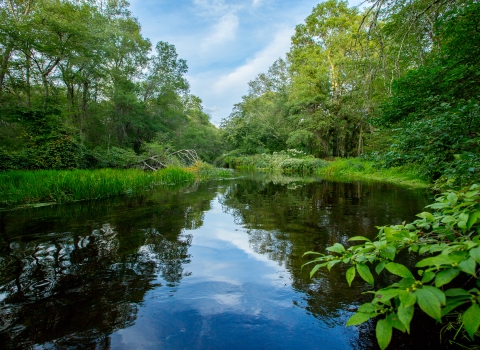For 25 years the U.S. Fish and Wildlife Service’s National Fish Passage Program has worked with partners across the country to remove 3,500 barriers to fish passage fish passage
Fish passage is the ability of fish or other aquatic species to move freely throughout their life to find food, reproduce, and complete their natural migration cycles. Millions of barriers to fish passage across the country are fragmenting habitat and leading to species declines. The U.S. Fish and Wildlife Service's National Fish Passage Program is working to reconnect watersheds to benefit both wildlife and people.
Learn more about fish passage and reopen 64,000 miles of previously inaccessible streams for fish and other wildlife.
Millions of aging, obsolete, or poorly designed dams, roads, and levees are causing widespread ecological damage and putting communities at risk. These barriers trap fish, preventing them from finding food, shelter, and habitat to spawn. Outdated and aging infrastructure affects us too: it degrades water quality, can heighten flood risk, and creates dangers for recreational users. Fortunately, restoring aquatic connectivity offers a win-win solution for both people and nature.
In 2021, $200 million in Bipartisan Infrastructure Law Bipartisan Infrastructure Law
The Bipartisan Infrastructure Law (BIL) is a once-in-a-generation investment in the nation’s infrastructure and economic competitiveness. We were directly appropriated $455 million over five years in BIL funds for programs related to the President’s America the Beautiful initiative.
Learn more about Bipartisan Infrastructure Law funding was allocated to the Service to restore fish and wildlife passage by removing in-stream barriers and providing technical assistance. Program projects funded to date under the Law have been diverse, and include dam removals, fishway constructions, and replacement of road culverts.
These projects reopen waterways for fish, mussels and other aquatic wildlife and also provide key benefits to the surrounding communities, in the form of jobs, protection from flooding, increased recreational opportunities and even improved access to necessities like grocery stores and medical care.
“By bringing together partners around shared goals, we reconnect and restore fragmented aquatic ecosystems,” said Eric MacMillan, a branch manager for the Service’s Fish and Aquatic Conservation Program. “In a truly national approach, we work at the invitation of landowners across all types of landownership and in every state. Addressing connectivity is a high-priority, cost-effective strategy for protecting and restoring fish populations while making human infrastructure safer and more resilient.”
Take a deep dive into the conservation, community and economic benefits of the Fish Passage Program in the recently released report, Healthy Rivers, Communities, and Economies.
Projects highlighted in this report include:
- Albert and Bessie Kronkosky State Natural Area, San Antonio, Texas: $130,000 to remove an earthen dam that is impeding the flow of a small spring, allowing the new state park to open sooner and benefitting the federally threatened Texas blind salamander.
- Maple River Reconnection Project, Muskegon, Michigan: $1.9 million to remove two culverts to allow a channel of the Muskegon River to reconnect with the Maple River, protecting fish habitat, people and property, and helping the community connect with each other, their history and waterways. The project will also benefit a stand of wild rice, or Manoomin, a culturally important resource for the Little River Band of Ottawa Indians.
- Upper Town Dam Removal, Lisbon, Maine: $350,000 to remove the Upper Town Dam and nearby Mill Remnant Dam which were creating downstream flood risks to properties and businesses along the Sabattus River. The project will also restore access for alewife, a species of herring, to Sabattus Pond.
- Trispot Darter Culvert Replacements, St. Clair County, Alabama: $1.1 million to replace failing culverts along Little Canoe Creek and a tributary that were causing flooding and damage on private property and at a local sports field complex. The project also benefits the federally threatened trispot darter.
- Numana Dam Removal, Pyramid Lake Paiute Tribe Reservation, Nevada: $8 million to remove the Numana Dam on the Pyramid Lake Paiute Tribe Reservation. The project will benefit federally endangered cui-ui and federally threatened Lahontan cutthroat trout by allowing them to access their historic spawning habitat in the Truckee River for the first time in more than 100 years.
- Little Tonsina River Bridge, Valdez-Cordova Borough, Alaska: $1.3 million to replace to undersized culverts that were routinely failing and cutting off access between coastal and interior Alaska communities. The project will also benefit Coho and Chinook salmon, both central to the way of life of most Alaska Native communities.




